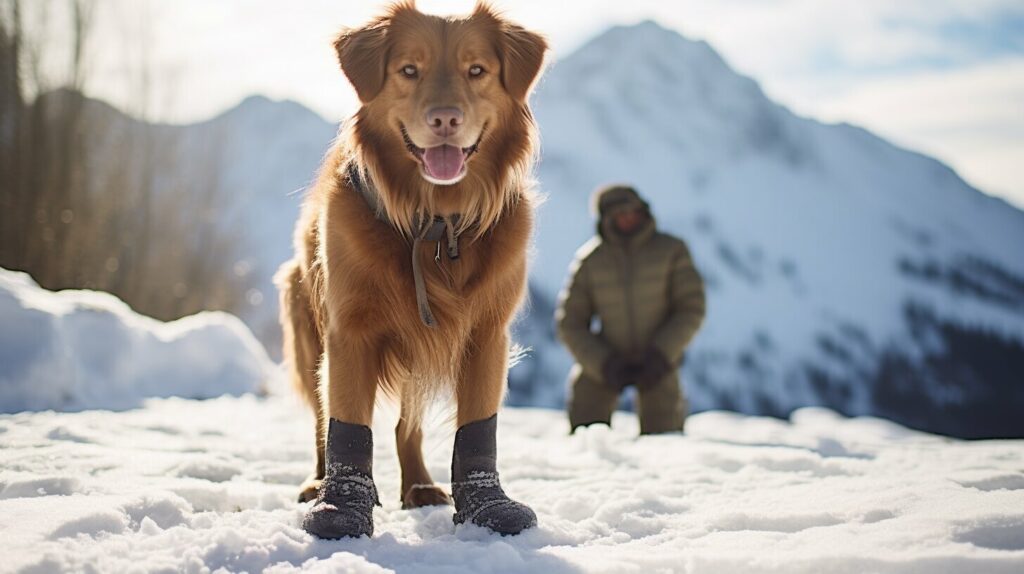Winter can be a challenging time for dogs, especially when it comes to protecting their paws. Cold temperatures, snow, ice, and potentially harmful chemicals used to treat roads and sidewalks can all take a toll on their sensitive paw pads. That’s why investing in a pair of winter boots for your dog can make a big difference in keeping them healthy and comfortable during the colder months.
Key Takeaways
- Winter boots for dogs are essential for protecting their paws from cold temperatures, snow, ice, and potentially harmful chemicals.
- Choosing the best winter boots for your dog involves considering factors like insulation, waterproofing, traction, and proper fit.
- Measuring your dog’s paws before purchasing boots is crucial to ensure a proper fit.
- Introducing winter boots to your dog takes patience and some helpful tips to make the transition easier.
- Maintaining and cleaning your dog’s winter boots is important to ensure their longevity and optimal performance.
- Additional accessories like paw balms, socks, and leg warmers can provide extra protection and comfort in extreme weather conditions.
- Reviews and recommendations for the top winter boots for dogs can help you make an informed purchase decision.
Why Winter Boots for Dogs Are Essential
During the winter season, the cold weather, snow, and ice can pose a significant risk to your furry friend’s paws. That’s where winter boots for dogs come in. These specially designed dog shoes for winter can provide much-needed protection for your pet’s paws, keeping them safe and comfortable in even the harshest conditions.
Winter boots for dogs can help prevent injuries caused by icy surfaces and snow buildup between their toes. They also protect your pet’s paws from harsh chemicals, such as salt and de-icers, used on roads and sidewalks. Without proper paw protection, your dog is at risk of developing frostbite, dry and cracked paw pads, and injuries from sharp objects hidden under the snow.
Cold weather dog boots come in various styles, including snow boots for dogs, insulated dog boots, and waterproof dog boots. Choosing the right winter boots for your dog is essential in ensuring their comfort and protection during winter activities such as snowshoeing, hiking, or playing in the snow.
Choosing the Best Winter Boots for Your Dog
With so many options available, it can be overwhelming to choose the best winter boots for your furry friend. Consider the following factors to ensure maximum protection and comfort:
| Factor | Consideration |
|---|---|
| Insulation | Look for boots with adequate insulation to keep your dog’s paws warm, especially in extremely cold temperatures. Thicker and heavier materials like neoprene and fleece are good options. |
| Waterproofing | Waterproof boots are crucial to protect your dog’s paws from getting wet in the snow or rain. Check for materials like rubber and nylon that offer good waterproofing. |
| Traction | Dogs need proper traction to prevent slips and falls, especially on icy surfaces. Choose boots with rubber soles or textured materials for better grip. |
| Proper fit | Ensure the boots fit your dog properly and are not too tight or loose. Most brands provide a size chart, and it’s essential to measure your dog’s paws before purchasing. |
| Warmth | Choose boots with a lining that is soft and comfortable. Look for fleece or other soft materials to keep your furry friend’s paws warm and cozy in the cold. |
Some popular brands and models of winter boots for dogs that meet these criteria include:
- Ultra Paws Rugged Dog Boots
- Ruffwear Polar Trex Dog Boots
- Hurtta Outback Dog Boots
- Qumy Dog Boots
Remember, the best winter boots for your dog depend on their individual needs and preferences. It may take some trial and error to find the right fit, so be patient and keep your dog’s comfort and safety in mind.
How to Measure Your Dog’s Paws for Boots
Getting the right fit for your dog’s winter boots is crucial for their comfort and safety. Here are the steps to correctly measure your dog’s paws:
- Have your dog stand on a piece of paper.
- Trace around one of their paws with a pen or pencil held perpendicular to the paper.
- Measure the length and width of the traced paw – from the longest point of the heel to the tip of the longest toe, and the widest distance across the paw respectively.
- Compare your measurements to the manufacturer’s size chart to find the appropriate boot size for your dog.
It’s essential to measure your dog’s paws regularly, as their paw size can change over time due to weight changes or age. Always measure their paws while standing, as this is when they will spread their toes the most, ensuring the most accurate fit.
Keep in mind that different boot brands may have slightly different sizing charts, so make sure to double-check before purchasing.
Tip: If you’re unsure between two sizes, choose the larger one – it’s always better to have a slightly bigger boot than a too-tight one that could restrict blood flow.
Tips for Introducing Winter Boots to Your Dog
When it comes to introducing your dog to winter boots, it’s important to take it slow and make the experience as positive as possible. Keep in mind that some dogs may not enjoy or tolerate wearing footwear, so patience and persistence are key. Here are some tips to help you and your pup through the process:
- Start with shorter wear times: It’s a good idea to start with short periods of wear, gradually increasing over time. This will help your dog get used to the sensation of wearing boots and reduce any discomfort or anxiety.
- Use Positive Reinforcement: Reward your dog with treats, praise, and affection when they allow you to put on and take off their boots. This will help them associate the experience with positive feelings and encourage cooperation.
- Choose the Right Time: Introduce your dog to boots when they are most relaxed and calm, like after a walk or exercise session. Avoid trying to put boots on when your dog is anxious or hyperactive.
- Practice Indoors: Initially, try putting the boots on indoors. This will give your dog a chance to get used to the sensation without distractions or obstacles.
- Check the Fit: Make sure the boots fit properly and are not causing any discomfort or irritation. Adjust the fit as needed, and monitor your dog’s behavior and body language while wearing the boots.
- Be Patient: Some dogs may need more time and patience than others. Don’t give up, and keep practicing until your dog is comfortable wearing boots.
By following these tips, you can help your furry friend stay warm and protected during the winter season. Remember, winter boots for dogs are an essential accessory that can prevent injuries and discomfort, so it’s worth the effort to introduce them properly.
Maintaining and Cleaning Your Dog’s Winter Boots
Now that you’ve invested in a pair of insulated winter boots for your dog, it’s important to maintain and clean them regularly to ensure optimal performance and longevity. Here are some practical tips to keep your dog’s boots in top shape:
- Before cleaning the boots, remove any dirt or debris that may have accumulated on the surface. You can use a soft-bristled brush or a damp cloth to wipe away the dirt.
- If the boots are muddy or heavily soiled, rinse them under running water to remove the excess dirt. Avoid using hot water or harsh chemicals, as they may damage the boots’ material and insulation.
- After rinsing, gently scrub the boots with a mild soap or detergent and rinse again. Make sure to remove all the soap residue, as it can cause irritation or discomfort to your dog’s paws.
- Allow the boots to air dry completely before using them again. Avoid exposing them to direct sunlight or high heat, as it can damage the material and weaken the structure.
- If your dog’s boots have an odor, you can sprinkle some baking soda or cornstarch inside and leave it overnight. In the morning, shake out the excess powder and wipe the boots with a damp cloth.
- Check the boots regularly for signs of wear and tear, such as holes, cracks, or loose seams. If you notice any damage, repair or replace the boots immediately to avoid compromising your dog’s paw protection.
By following these simple steps, you can maintain and clean your dog’s winter boots effectively and ensure they provide maximum protection and comfort during the cold season.
Additional Accessories for Winter Paw Protection
Winter boots for dogs are a great way to protect your pup’s paws from cold, snow, ice, and potentially harmful chemicals used to treat roads and sidewalks. However, sometimes boots alone may not be enough to provide the necessary protection, especially in extreme weather conditions. Luckily, there are other accessories that can complement your dog’s winter boots and provide additional comfort and safety.
Paw Balms
Paw balms are a great addition to your winter paw protection routine. They are designed to moisturize and protect your dog’s paw pads from cracking and drying out due to cold weather. The balms form a protective layer on the pads, which helps to prevent irritation and damage from the ice and snow.
When choosing a paw balm, look for one that is made from natural ingredients like beeswax, coconut oil, and shea butter. It’s also important to make sure that the balm is safe for dogs and does not contain any harmful chemicals.
Socks
Dog socks can provide extra warmth and protection for your pup’s paws in frigid temperatures. They are made of soft and comfortable materials that can help to regulate your dog’s body temperature and keep their feet dry.
When choosing socks for your dog, make sure they fit properly and are not too tight or too loose. Socks that are too tight can restrict circulation and cause discomfort, while socks that are too loose can slip off and become a safety hazard.
Leg Warmers
Leg warmers are another accessory that can provide added warmth and protect your dog’s legs from snow and ice. They are especially useful for dogs with short fur who are more sensitive to the cold.
When choosing leg warmers, make sure they fit snugly and do not restrict your dog’s movement. It’s also important to choose materials that are comfortable and breathable to avoid overheating.
By adding these accessories to your dog’s winter paw protection routine, you can ensure that they stay warm, dry, and comfortable in even the coldest of temperatures.
Reviews and Recommendations: Top Winter Boots for Dogs
Choosing the best winter boots for your furry friend can be overwhelming with so many options available in the market. To help you make an informed decision, we’ve shortlisted the top winter boots for dogs based on their features, performance, and customer feedback. Here are our recommendations:
| Brand/Model | Key Features | Price |
|---|---|---|
| Ruffwear Grip Trex | Waterproof, breathable, and durable with Vibram non-marking outsole for traction. | $74.95 |
| QUMY Dog Boots | Waterproof, anti-slip, and made with soft and breathable fabric with adjustable straps for a secure fit. | $29.99 |
| Ultra Paws Rugged Dog Boots | Water-resistant, lightweight, and flexible with foam comfort pad and non-skid sole. | $34.95 |
| Kurgo Step & Strobe Dog Boots | Water-resistant, durable, and features LED lights for added visibility during nighttime walks. | $74.99 |
| Pawz Water-Proof Dog Boots | Disposable, waterproof, and made with natural rubber for maximum paw protection. | $14.99 |
When choosing the best winter boots for your dog, it’s important to consider their specific needs and preferences. If your dog has sensitive paws, you may want to opt for boots with extra padding or soft lining. If they enjoy outdoor activities like hiking or running, look for boots with excellent traction and durability. No matter what you choose, make sure the boots fit properly and provide comfort and protection for your furry friend’s paws.
Investing in a good pair of winter boots for your dog can make all the difference in keeping them safe and comfortable during the cold season. With our top recommendations, you can choose the best winter boots for your furry friend with confidence.
Conclusion
In conclusion, winter boots for dogs are essential to protect your furry friend’s paws during the cold season. Snow, ice, and potentially harmful chemicals used to treat roads and sidewalks can all cause damage and discomfort to your dog’s sensitive paw pads.
When choosing the best winter boots for your dog, consider factors such as insulation, waterproofing, traction, and proper fit. Measure your dog’s paws to ensure a comfortable fit and follow tips for introducing the boots gradually to your dog.
Remember to maintain and clean your dog’s winter boots to ensure they last longer and provide optimal performance. Consider complementing the boots with accessories such as paw balms, socks, and leg warmers for extra protection and comfort in extreme weather conditions.
Overall, by prioritizing your dog’s paw protection with winter boots, you can ensure they stay safe, comfortable, and healthy throughout the winter season. So, don’t hesitate to invest in a pair of high-quality winter boots for your furry friend today!
FAQ
Q: Why do dogs need winter boots?
A: Dogs need winter boots to protect their paws from cold temperatures, snow, ice, and potentially harmful chemicals used to treat roads and sidewalks.
Q: What should I consider when choosing winter boots for my dog?
A: When choosing winter boots for your dog, consider factors such as insulation, waterproofing, traction, and proper fit. It’s important to find boots that will keep your dog’s paws warm, dry, and provide adequate grip.
Q: How do I measure my dog’s paws for boots?
A: To measure your dog’s paws for boots, follow these steps: 1) Place your dog’s paw on a piece of paper and trace the outline. 2) Measure the length and width of the paw outline. 3) Use these measurements to determine the appropriate size of boots for your dog.
Q: How can I introduce winter boots to my dog?
A: Introducing winter boots to your dog can be done gradually. Start by allowing your dog to sniff and investigate the boots before trying them on. Then, gradually increase the amount of time your dog wears the boots indoors, rewarding them with treats and praise. Be patient and make the experience positive for your dog.
Q: How should I maintain and clean my dog’s winter boots?
A: To maintain and clean your dog’s winter boots, remove any dirt or debris after each use. Use a mild soap and water solution or a pet-friendly cleaner to gently clean the boots. Allow them to air dry completely before storing them.
Q: Are there any additional accessories for winter paw protection?
A: Yes, there are additional accessories that can complement winter boots for dogs. Paw balms can provide extra protection and moisturization, while socks and leg warmers can add an extra layer of warmth in extreme weather conditions.
Q: Can you recommend some top winter boots for dogs?
A: There are several top winter boots for dogs available in the market. Some highly recommended options include [provide specific recommendations based on the article’s research and reviews]. These boots have proven features, performance, and positive customer feedback.



